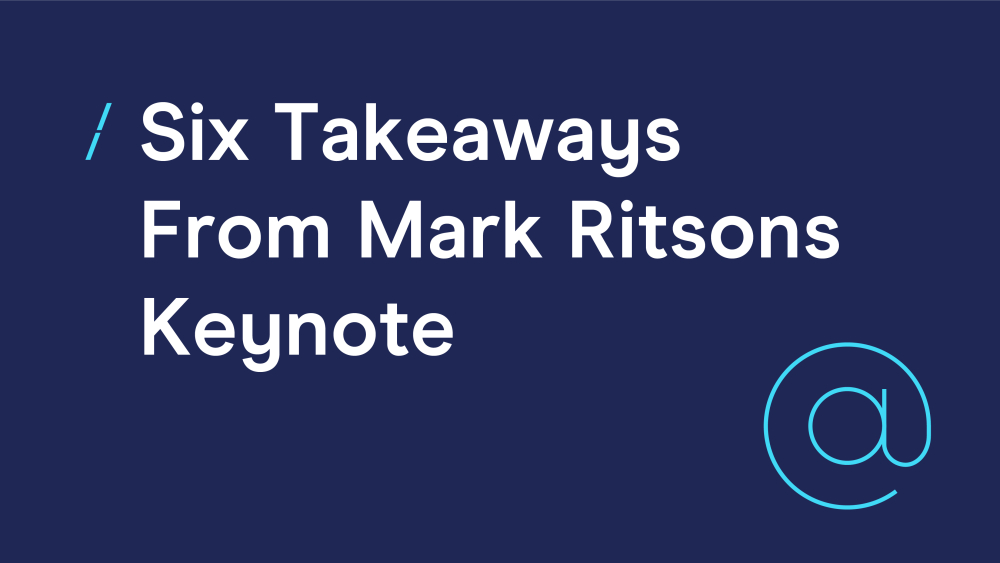Six takeaways from Mark Ritson's keynote with Spotler
25 Apr 2022

Written by Komal Helyer, Fractional CMO and Chair of the DMA's Email Council.
Last week I was honoured to speak on a webinar, sponsored by Spotler, that featured Mark Ritson as a keynote. Mark, a marketing force to be reckoned with, has been a brand consultant and former marketing professor for over 25 years, He has now launched his own mini MBA course, which is gaining great esteem.
Mark’s on a mission to create a world of better marketers, and in turn he is revered by brands and practitioners globally. So you can imagine my excitement as I sat down to listen intently to his passionate 60 minutes keynote.
Here are the 6 things I learned.
1. Marketing is broader than selling
Mark Ritson loves Peter Drucker.
Peter Drucker is one of the most influential thinkers on management, heralded as the father of modern management. He never was a marketer. But yet he has become one of the most prominent public marketers of marketing.
For Drucker, Marketing is one of the most crucial areas of business - “Marketing is not only much broader than selling; it’s not a specialised activity at all. It encompasses the entire business.” The fact that he did not consider himself a marketer made this emphasis even more credible.
Marketing encompasses the entire business. This is an important principle that we must remember when putting together objectives and planning – the principle that we’re here to support the whole customer lifecycle, not just one part of the funnel. It’s a principle that’s often forgotten when we are beholden to the sales teams!
But also one that needs to be remembered when setting objectives, which we will come back to later.
Mark goes on to remind us that Drucker also said that the business’s reason to exist is to create a customer and that marketing must learn to understand its customer.
“The aim of marketing is to know and understand the customer so well the product or service fits him and sells itself.” “The purpose of the business is to create and keep a customer.”
So how can we truly understand the customer? It’s more challenging than it first sounds.
2. We need to focus on Market Orientation.
Mark reminds marketers that to truly understand the consumer is not to look at them head on, but to do a 180 turn and look at how the customer sees the business.
If you can see things from how the customer sees things and not how your business sees its customer, it completely changes perspective. This is being market oriented.
Let’s take a look at an example. If you’re not market oriented, you might think that your brand is super important. You overstate its value and importance to consumers. Like they care about your brand?! Even if you have a super strong brand, no one really cares! If you are not market oriented you start thinking that your brand plays a much bigger role in in people’s lives than it actually does.
Actually, there’s nothing wrong with believing and understanding that your brand plays a very small role in the lives of your customer. In fact, if you did this then you might build a much better brand strategy.
According to Mark Ritson, badly trained marketers are not focussed on market orientation. Therefore they cut straight to doing tactics and communications before they’ve even understood what the customers think.
We need to change this.
3. We need to mix both long & short term strategies
Let’s go back to our pal Peter Drucker. He once wrote that the business’s job is to keep their nose to the grindstone whilst lifting their eyes to the hills.
What he meant by this, is that a business should operate in two modes at the same time: results for today, whilst preparing for tomorrow (the short and long term). Be mindful though that the long term is not simply the adding up of the short-terms!
Drucker and his team looked at hundreds of case studies of marketing. They were looking for examples of growth, otherwise known as sales uplift over base. And they also looked at how this growth happened over time.
What they found was there are two trajectories to growth.
Let’s look at the graph below:
Here we can see there are two lines – the first is the red. This is the short term strategies, Mark refers to this as performance marketing.
Performance marketing has a direct response goal and the channels generally include social, PPC, email, search, digital ads and so on. And it’s a great thing, because when you spend a little bit of money, the resulting effect is that sales get an uplift.
However, the issue is that when you take your foot off the pedal and stop spending, sales go back to where they were. Now, there’s nothing wrong with that is there? You put some money in you get some back. Basically how most marketing teams behave and are targeted.
But there’s a second trajectory to growth, this is seen in the blue line. This is the long tail of brand building – yes for sure it is more incremental, which takes time, but it builds to set up future sales.
So if you are using both approaches, what you get is a compounding effect of increased sales and ROI over time.
This is all pretty easy to understand right? So why aren’t more businesses doing this?
Well that’s because most companies don’t look at a 5 year plan. They’re usually focussed on delivering results for that quarter. Therefore, we think we see that the better ROI comes from those things that you do today that deliver results right now. And that comes from performance marketing. This is where we spend most of our budgets and efforts. However, as we mentioned before with this type of marketing, as soon as you take the pedal off sales start dropping. So short term focussed marketing teams are in a perpetual groundhog day.
Let’s take a look at how the long and the short works in practice with this example from UBER. Uber have been doing a great job of splitting focus on brand and performance.
Creative 1 - The Long. This type of campaign uses media such as outdoor, TV and cinema. And it’s all about the emotional benefit of getting home. There’s no product, there’s no offer, there’s no activation. It’s all about the heartstrings. The guy opens the door, there’s his kid and boom he’s home. It is pure emotion – it’s brand!
Creative 2 - The Short. Uber is also always running more targeted , product based activations. This campaign is data driven, targeted to lapsed users with an offer to get you back to using their cars.
So, you see the difference. But you also see that the power comes when these two are used in tandem.
4. Segmentation + Mass = Success
This leads us really nicely to our next point. Who are your target markets for long and short term strategies? Based on research, Mark demonstrated that the mix is simple.
For short term activation, clear segments with differentiated messages and offers delivers the best results. However when looking at long term brand campaigns, the stuff that sits at the top of your funnel, segmentation isn’t necessary. Go after everyone in the category, if you can afford to do this!
Be emotional with your broad brand message, then don’t be afraid to hit the targeted segments with personalised product and offer messages for activation.
5. Have clear and defined objectives
According to Mark, one of the biggest problems for brands is the lack of clarity and problem definition when briefing agencies or contractors, together with a lack of clear objectives.
Most of the time marketers don’t have objectives defined. So when we’re speaking to internal teams or external partners there’s a lack of direction. Which then leads to failure.
We need to ensure we don’t overlook this stage.
We need to make choices, we need to understand and define our targets. What are we trying to achieve and who for? They don’t even have to be the right ones, as that’s what testing is for. But we need to decide, with clarity, what they are.
Mark also goes on to say that we need to keep the number of objectives low. Research has shown that a handful of strategic objectives (3 or 4) are much more likely to succeed than 8 or more.
To learn more about setting objectives, read Pure360's guide here.
6. Distinction instead of differentiation
Most marketers will plan their marketing based on differentiation from the other leaders in the industry. Distinctiveness, however, is not about the competitor.
Distinctiveness is about how much your brand stands out in the customers head when they’re hungry, for example.
Research shows that distinctiveness is rapidly growing more important than differentiation. And why is that?
If we look at the Nobel prize winning work of Daniel Kahneman of Thinking Fast and Slow, it is believed there are two systems used for thinking.
System two which is a slow, conscious effort, for example, when you’re choosing an apartment to rent or purchasing a mortgage.
And then there’s system one that is thinking so fast that you’re not even aware of it. Actually it could be full of many errors – but you don’t even care.
Let’s look at an example. This morning you went to buy a coffee, and the barista asked you what kind of coffee you would like and you chose a cappuccino. You literally have no idea where that came from, you just said cappuccino because your system one said you wanted that.
There is an old school of thought that 25% of your job is to make your people aware of your brand and the other 75% was to differentiate it – giving it a brand image that was different and more positive than the competition.
However as we learn more about behavioural science and how consumers truly think, we’re seeing a reversal of the two.
Mark’s belief is that most of your job is ensuring your brand comes to mind in buying situations. And if it does, you’re already pretty close to success.
Let’s take a look at another example. This time from Ehrenberg-Bass, the Institute for Marketing Science in Australia. They conducted some research that discovered that if you saw 10 TV ads last night you can remember about 4 of them. Then if we ask you which brands you remembered, that number will go down to about 16%.
And which 16% of brands do we remember? The ones that were distinctive. The ones you would remember if you were half asleep or had one too many. Great brands are those whose creatives are distinctive whatever they do.
Focus on distinction over differentiation.
Conclusion
You may immediately wonder why I have not mentioned anything about email or marketing automation. Mark is a brand man – he talks about the big picture stuff. However, every single lesson learned can be applied to the nuances of our field. It gives us food for thought and above all regardless of our subject matter expertise, we are all marketers. We must think and act like marketers to be successful.
Watch the full session with Mark here.




Please login to comment.
Comments